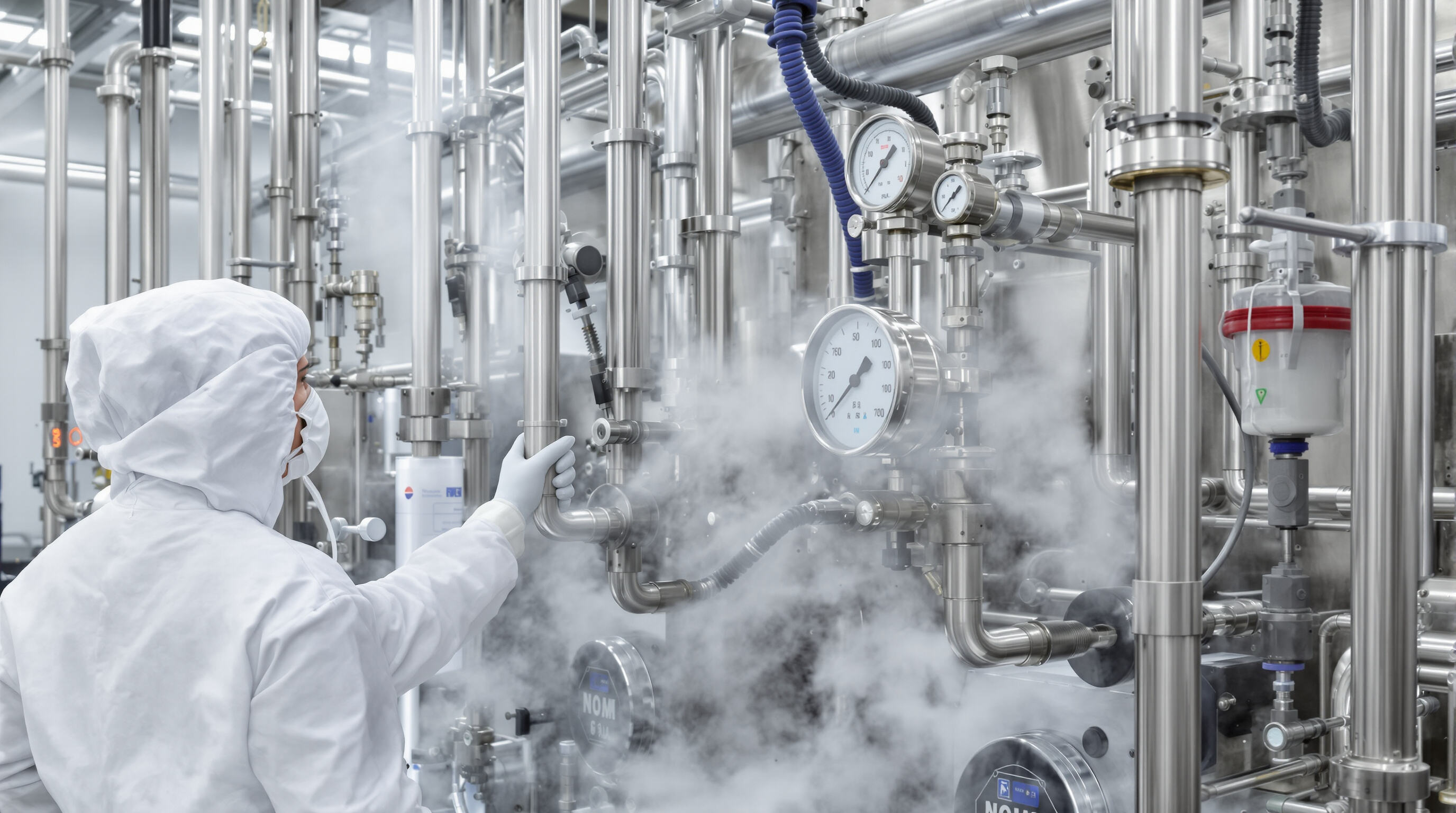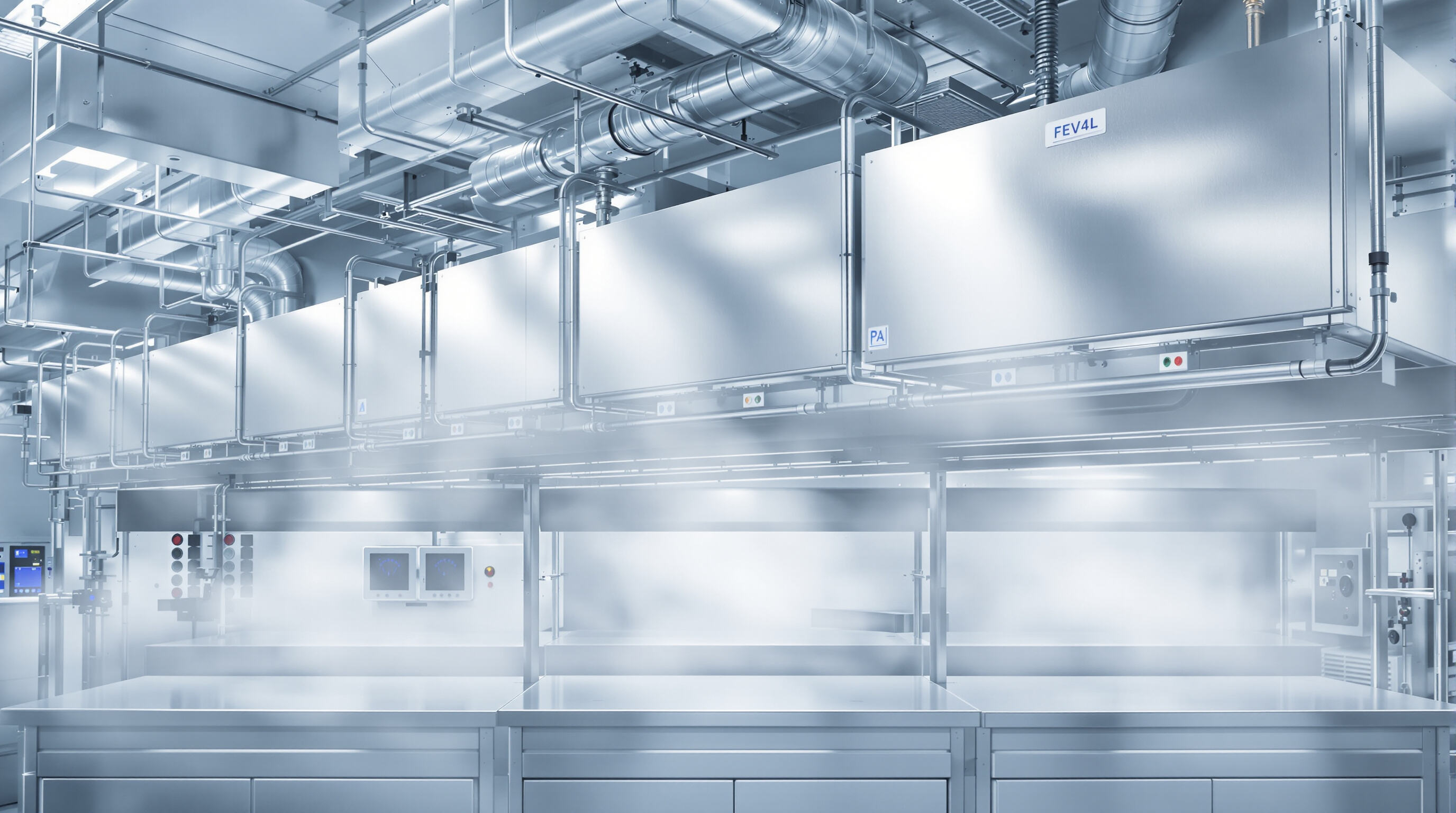Aplikasi Penjana Wap Tulen EcoSteam Selain Pensenyawaan
Pembuatan Farmaseutikal & Bioteknologi: Penggunaan Wap Tulen yang Kritikal dalam Proses

Peranan Wap Tulen dalam Proses Pengeluaran Biologik dan Suntikan
Penjana stim yang menghasilkan stim tulen memainkan peranan kritikal dalam pengeluaran produk steril seperti ubat suntikan dan biologik. Apabila tiada endotoksin dalam stim, bahan berbahaya dapat dihalang daripada memasuki larutan parenteral yang kita suntikkan secara langsung ke dalam aliran darah pesakit. FDA dan Agensi Ubatan Eropah juga menetapkan peraturan ketat berkenaan perkara ini. Mereka mensyaratkan kebolehtelapan stim kurang daripada 0.25 EU per mililiter, yang jujur sahaja hanya boleh dicapai dengan teknologi penyulingan dan pemisahan yang agak canggih pada masa kini. Berdasarkan nombor sebenar dari industri, kira-kira dua pertiga daripada semua kelewatan pengeluaran dalam pengeluaran biologik sebenarnya disebabkan oleh masalah kualiti stim. Oleh itu, kebanyakan kemudahan melabur secara berat dalam sistem stim berskala farmaseutikal yang sesuai. Memenuhi keperluan kepatuhan bukan sahaja berkaitan dengan dokumen semata-mata; ia secara literal memastikan operasi berjalan lancar tanpa gangguan berterusan.
Pengintegrasian dengan Penyelesaian Bilik Bersih Modular dan Tersepadu untuk Kejernihan
Kebanyakan bilik bersih moden kini bergerak ke arah konfigurasi modular, sering kali merangkumi sistem pengagihan stim tulen yang disepadukan. Ini membolehkan pensanitasian segera pada pelbagai komponen seperti isolator, talian pengisian, dan kamar pengeringan beku yang sukar dikendalikan. Manfaat sebenar terletak pada keupayaan sistem terkini ini mengekalkan piawaian Kelas A/B dengan berjaya menghapuskan kawasan sejuk yang mengganggu kitar SIP. Ini sebenarnya sangat penting kerana kajian menunjukkan bahawa kira-kira 22 peratus masalah dalam proses aseptik berlaku apabila rangkaian stim lama gagal mengagihkan haba secara sekata di seluruh ruang bilik bersih.
Menyokong Pensanitasian Bilik Bersih dan Kawalan Kelembapan dalam Persekitaran Aseptik
Selain pensenyawaan peralatan, stim tulen menyokong kawalan kelembapan yang tepat (45–55% RH) melalui suntikan langsung, mengurangkan risiko pencemaran zarah berbanding pelembap konvensional. Kaedah ini mengekalkan piawaian kualiti udara ISO 14644-1 semasa jangka pengeluaran yang panjang, memastikan keadaan stabil untuk proses yang sensitif.
Kajian Kes: Pelaksanaan Penjana Stim Tulen Mengurangkan Risiko Pencemaran
Sebuah kemudahan biofarmaseutikal di Eropah berjaya mengurangkan kadar penolakan kelompok sebanyak 58% selepas meningkatkan sistem kepada penjana stim tulen dengan pemantauan TOC automatik. Sistem baharu ini telah membasmi pencemaran pirogen dalam pengeluaran antibodi monoklonal, menjana penjimatan tahunan sebanyak $2.8 juta hasil daripada pengelakan kerja semula dan denda peraturan.
Analisis Kontroversi: Naratif Pensenyawaan yang Menghadkan Penerimaan Lebih Luas
Walaupun 76% profesional dalam industri memandang stim tulen secara semata-mata sebagai alat pensenyawaan, persepsi sempit ini mengabaikan nilainya dalam formulasi biologik dan persediaan bekas kriogenik. Jurutera berhujah bahawa mentakrifkan semula sistem stim di luar pensenyawaan boleh mempercepatkan inovasi dalam pengeluaran berterusan dan integrasi bioreaktor guna tunggal.
Pelembapan Presisi dalam Persekitaran Terkawal Menggunakan Penjana Stim Tulen

Stim Kepujian Tinggi untuk Pelembapan Presisi dalam Proses Bilik Bersih
Penjana stim tulen boleh menghasilkan tahap kelembapan berkualiti farmaseutikal dengan variasi kelainan stim kurang daripada 1%. Ini memenuhi piawaian ketat yang ditetapkan oleh keperluan ISO 14644 Kelas 5 untuk bilik pembersihan. Sistem ini berfungsi secara berbeza daripada sistem biasa kerana ia menggunakan pelbagai peringkat penapisan bersama dengan teknik pemisahan haba yang sebenarnya mengelakkan masalah pembentukan mineral yang sering dilihat pada peralatan biasa. Menurut kajian yang diterbitkan tahun lepas, syarikat-syarikat melaporkan masalah kelembapan yang tidak konsisten berkurang sebanyak satu pertiga apabila mereka beralih kepada teknologi stim tulen. Ini memberi perbezaan besar dalam operasi yang sensitif, seperti penyejatan beku, di mana perubahan kecil dalam kandungan kelembapan boleh menjejaskan kualiti dan kestabilan produk sepanjang pengeluaran.
Kelebihan Berbanding Penghumidifikasian Tradisional Dalam Mengekalkan Kualiti Udara Yang Mematuhi ISO
Sistem stim tulen memberi prestasi yang lebih baik daripada pelembap konvensional dalam bidang-bidang kritikal:
- Tiada risiko pencemaran mikroba daripada patogen berkumpul dalam air, berbeza dengan sistem berasaskan elektrod
- Tindak Balas Segera dengan ketepatan ±0.5% RH, berbanding kelambatan 3–5 minit dalam sistem tradisional
- 40% penjanaan zarah yang lebih rendah , menurut data pensijilan bilik pembersihan 2024
Ketiadaan aditif kimia menghalang interaksi reaktif dengan bahan aktif farmaseutikal (API) yang sensitif dan antibodi monoklonal, menyelesaikan cabaran berterusan dalam pengeluaran biologik.
Trend: Peningkatan Permintaan untuk Kecekapan Tenaga dan Kelestarian dalam Penjanaan Stim untuk Sistem HVAC
Penjana stim tulen hari ini menjimatkan sekitar 22% tenaga berbanding model lama berkat sistem pemulihan haba gelung tertutup mereka, yang sesuai dengan apa yang diwajibkan oleh FDA dalam peraturan kelestarian 2023 mereka. Melihat kepada trend industri, Laporan Generasi Stim Amerika Utara terkini dari 2024 menunjukkan sesuatu yang agak menakjubkan - terdapat hampir tiga kali ganda jumlah sistem stim tulen dengan pemanasan awal solar yang dipasang sejak 2021. Pertumbuhan ini juga bukan berlaku secara kebetulan. Syarikat-syarikat sedang menghadapi tekanan daripada peraturan dan juga melihat penjimatan wang yang nyata dalam tempoh jangka panjang. Pengiraan ini boleh dibuktikan apabila melihatkan kos keseluruhan hayat produk: perniagaan boleh menjangkakan penjimatan sebanyak kira-kira $740,000 dalam tempoh sedekad dengan sistem yang lebih baharu ini. Gabungan insentif kewangan sebegini bersama-sama faedah persekitaran menjadikan tidak menghairankan lagi mengapa lebih banyak kemudahan beralih menggunakan sistem ini.
Industri Makanan & Minuman: Aplikasi Bukan Pensenyawaan Stim Tulen
Suntikan Stim Langsung dalam Pemprosesan Makanan Sensitif yang Memerlukan Keaslian Gred Farmaseutikal
Ramai pengeluar makanan beralih kepada penjana stim tulen apabila mereka memerlukan stim yang bersentuhan secara langsung dengan makanan kerana stim memasak biasa kadangkala boleh mencemarkan apa yang dihasilkan. Kebanyakan ketuhar stim tradisional bergantung kepada perencat kakisan yang meninggalkan sisa pada barangan yang halus seperti susu formula bayi, serbuk protein vegan, dan minuman saji tunggal yang selalu kita ambil secara segera. Peralihan ini juga masuk akal dari segi keselamatan. Kebanyakan syarikat ingin kekal mengatasi peraturan, terutamanya selepas FDA mengemaskini peraturan FSMA 2023 mengenai pencegahan bahaya kimia dalam makanan yang dianggap berisiko. Sebilangan pakar industri menyatakan langkah ke arah stim yang lebih bersih ini sebenarnya semakin menjadi amalan piawai, bukan sekadar mematuhi peraturan.
Pematuhan dengan Piawaian Keselamatan Makanan dengan Menggunakan Penjanaan Stim yang Mampan dan Berkarbon Rendah
Teknologi stim tulen memenuhi keperluan keselamatan makanan dan kelestarian yang terus berkembang:
- Tiada aditif ketuhar stim , menyokong kepatuhan dengan piawaian organik USDA NOP 205.605
- 67% pelepasan CO₂ yang lebih rendah berbanding sistem stim masakan konvensional (Laporan Pemprosesan Makanan Mampan 2024)
- Pengambilan semula air gelung tertutup mengurangkan air buangan sebanyak 40% dalam operasi berterusan
Analisis industri terkini menunjukkan bahawa 82% penarikan balik makanan Kelas II FDA sejak 2022 melibatkan pencemaran daripada aditif sistem stim—a risk yang secara semulajadinya dielakkan dengan stim tulen.
Kemudahan Kesihatan: Mengembangkan Penggunaan Stim Tulen Melebihi Pensenyawaan Peralatan
Kesterilan dalam Pengilangan Farmaseutikal melalui Persekitaran Pengkompaunan Disokong Stim
Banyak hospital telah mula menggunakan penjana stim tulen untuk memastikan kawasan campuran mereka mematuhi piawaian USP <797> apabila mengendalikan ubat berisiko tinggi tersebut. Apakah yang menjadikan sistem ini begitu berkesan? Sistem ini berjaya mengurangkan bilangan zarah kepada kira-kira 3,500 per meter padu di dalam isolator dengan menyuntik stim secara tepat. Ini menangani kekurangan serius dalam kaedah pensenyawaan manual tradisional, terutamanya penting untuk rawatan kemoterapi dan penyelesaian nutrisi intravena. Yang lebih menarik? Penjana ini dilengkapi dengan pemantauan binaan yang memeriksa kualiti stim semasa proses berjalan, yang bermaksud ahli farmasi boleh menyediakan ubat steril secara terus di klinik tanpa bimbang akan risiko kontaminasi. Bagi kemudahan yang mengendalikan persediaan ubat sensitif, jaminan secara masa nyata seperti ini semakin menjadi keperluan utama.
Penjanaan Stim Suhu Tinggi Tekanan Tinggi untuk Pelembapan dan Kawalan Jangkitan di Seluruh Bangunan
Kini, kebanyakan hospital telah beralih kepada penjana stim tulen untuk mengawal kelembapan di seluruh bangunan mereka, sejajar dengan garis panduan terkini daripada EMA Annex 1 pada tahun 2023. Sistem ini memastikan gas bukan kondensasi berada di bawah 3% di kawasan pengendalian udara yang penting. Stim ini beroperasi pada suhu tinggi, iaitu sekitar 130 hingga 150 darjah Celsius, menjadikan ia sangat sukar untuk kuman hidup di dalam saluran HVAC dan membantu mencegah jangkitan daripada merebak ke seluruh kemudahan. Beberapa peningkatan terkini dalam sistem ini sebenarnya berjaya menjimatkan kos tenaga sebanyak kira-kira 35% berbanding dengan sistem ketuhar lama. Penjimatan ini adalah hasil daripada pemindahan haba yang lebih baik antara stim dan udara, sesuatu yang pengeluar telah bekerja keras untuk mencapainya dalam tempoh yang agak lama.
Kes Penggunaan Penyelidikan & Akademik: Stim Tulin dalam Proses Sains Maju dan Proses Berskala Makmal
Menyokong pemprosesan bio-eksperimen dengan sistem penjana stim tulen dalam farmaseutikal
Bagi kerja-kerja penyelidikan yang serius, menjaga kebersihan adalah sangat penting kerana walaupun kontaminasi kecil boleh merosakkan keseluruhan eksperimen. Oleh itu, penjana stim tulen memainkan peranan penting—ia dapat menghilangkan endotoksin dan bahan-bahan biologi yang mungkin mencemari eksperimen pemprosesan biologi. Ini membantu mengekalkan persekitaran steril yang diperlukan untuk membiakkan tisu dan menjalankan kultur sel dalam bioreaktor. Dalam pengeluaran produk farmaseutikal, stim yang memenuhi piawaian tinggi benar-benar memberi kesan kepada keutuhan bahan biologi semasa penyediaan media dan pensanitasian bioreaktor, yang menjadi sangat penting apabila bekerja pada rawatan tersuai seperti imunoterapi tertentu. Menurut satu kajian daripada Northeastern University pada tahun 2023, makmal yang beralih kepada stim tulen mengalami masalah kontaminasi sebanyak satu pertiga kurang dalam kultur mereka. Namun begitu, kebanyakan ketua makmal (sekitar dua pertiga) masih menghadapi masalah ketulenan yang menyebabkan keputusan mereka terjejas dalam kajian imunologi yang halus.
Kecekapan tenaga dan keberlanjutan dalam penjanaan stim untuk aplikasi berskala makmal
Kolej dan universiti di seluruh negara kini beralih kepada penjana stim tulen apabila mereka berusaha mencapai matlamat kehijauan tanpa kehilangan ketepatan dalam operasi mereka. Nombor-nombor ini memberi gambaran yang jelas—sistem-sistem ini dapat mengurangkan penggunaan tenaga sebanyak kira-kira 40 peratus dan memotong keperluan air sehingga 55 peratus berbanding dengan ketuhar stim tradisional yang digunakan dalam sistem pemanasan kampus. Makmal-makmal yang terlibat dengan proses penapaian mendapati perkara ini sangat membantu memandangkan pensterilan sahaja boleh menghabiskan sehingga separuh daripada penggunaan kuasa di kebanyakan kemudahan, menurut data industri dari tahun lepas. Apa yang membezakan sistem-sistem ini adalah reka bentuk modularnya, yang membolehkan penyelidik hanya membayar apa yang benar-benar mereka gunakan semasa eksperimen yang dijalankan secara tidak kerap. Tambahan pula, terdapat ciri pemulihan haba buangan yang turut membantu mempercepatkan pelan ambisius untuk menjadikan makmal-makmal bebas karbon di seluruh kampus jauh sebelum tarikh sasaran 2028.
Soalan Lazim
Apa itu stim tulen dan mengapa ia penting dalam pengeluaran farmaseutikal?
Stim tulen ialah stim berkepekatan tinggi yang bebas daripada kontaminan, digunakan untuk memastikan kesterilan dalam produk farmaseutikal, terutamanya ubat suntikan dan biologik. Ia memainkan peranan penting dalam mencegah pencemaran dan memastikan kepatuhan terhadap piawaian ketat FDA dan EMA.
Bagaimana stim tulen memberi manfaat kepada persekitaran bilik bersih?
Stim tulen menyokong persekitaran bilik bersih dengan menyediakan pensenyawaan segera, mempertahankan kawalan kelembapan, dan mengekalkan piawaian kualiti udara ISO tanpa memperkenalkan risiko pencemaran yang biasanya dikaitkan dengan pelembap konvensional.
Apakah beberapa aplikasi bukan pensenyawaan stim tulen?
Selain pensenyawaan, stim tulen digunakan dalam industri makanan dan minuman untuk suntikan stim langsung dalam pemprosesan makanan sensitif, memastikan keselamatan dengan mengelakkan pencemaran daripada stim memasak biasa dan memenuhi piawaian keselamatan makanan.
Mengapa kemudahan kesihatan menggunakan penjana stim tulen?
Kemudahan kesihatan menggunakan penjana stim tulen untuk kawalan kelembapan dan pencegahan jangkitan. Sistem-sistem ini berkesan menguruskan pensterilan dalam persekitaran penyediaan farmaseutikal dan memastikan pematuhan dengan piawaian yang dikemaskini.
Bagaimana stim tulen menyumbang kepada kecekapan tenaga dan keberlanjutan?
Penjana stim tulen meningkatkan kecekapan tenaga dan keberlanjutan dengan mengurangkan penggunaan tenaga, menurunkan keperluan air, dan memasukkan sistem pemulihan haba buangan, menyokong matlamat alam sekitar serta menawarkan penjimatan kewangan dari masa ke masa.

 EN
EN







































